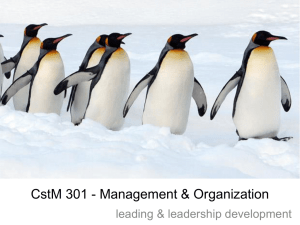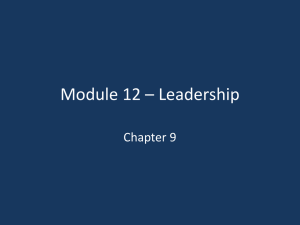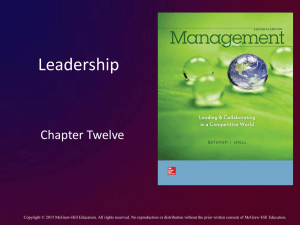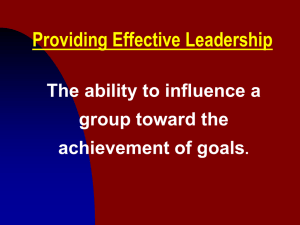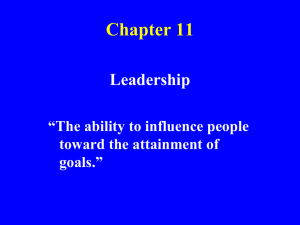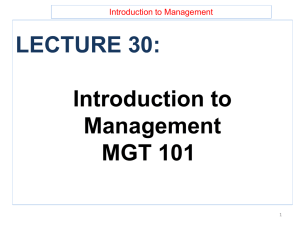Week 8 - June 28
advertisement
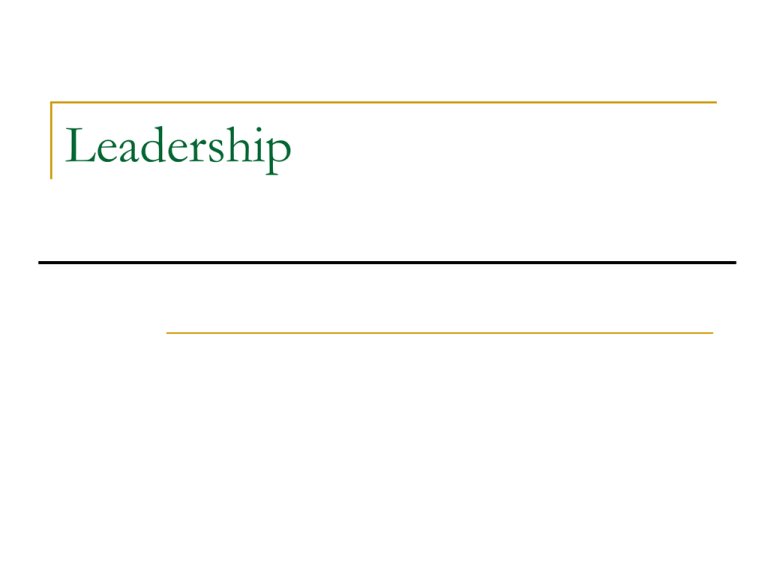
Leadership Student Presentations Dammein Hurdle Brian Sheeran Jacelyn Lopez-Bello Willie Douglas J.R. Gonzalez Dilcia Vasquez Abubakar Quartey What is Leadership? “There are almost as many definitions of leadership as there are persons who have attempted to define the concept.” Stodgill, 1981. p. 7 " ...leadership is like the Abominable Snowman, whose footprints are everywhere but who is nowhere to be seen“ Bennis & Nanus, 1997 What is Leadership? • Leadership is the “behavior of an individual … directing the activities of a group towards a shared goal.” Hemphill and Coons, 1957 “Leadership is about innovating and initiating … Leadership is creative, adaptive, and agile … Leadership looks at the horizon, not just at the bottom line.” Bennis and Goldsmith, 1994, p. 4 What Is Leadership? In their book, Reframing Organizations, Bolman and Deal say the answer seems to fall into the following categories: • • • • Ability to get others to do what you want Leaders motivate people to get things done Leaders provide a vision Leadership is facilitation Bolman, L.G., & Deal, T.E. (1997). Reframing organizations: Artistry, choice, and leadership. (2nd ed.). San Francisco, CA: Jossey-Bass. Definition of Leadership A passion for your goals An understanding of your medium Examples: Microwave multiplexer designer Journalist Politician? We are most interested in people leadership Exercise - Changes in Leadership In the first column of the worksheet at table, list the significant ways in which your business is changing. What is changing? What does the business have to do to cope? Changing Environment Worksheet What’s Changing Customers expect immediate response Organization Response Exercise - Changes in Leadership In the second column, list the things your organization must do to cope with the change listed in the first column. How must the organization behave differently to meet the changes? Changing Environment Worksheet What’s Changing Customers expect immediate response Organization Response Must reduce cycle time for production of widgets Exercise - Changes in Leadership Form small groups Describe change and organization response Determine what leadership behaviours are required to lead organization (last column) Changing Environment Worksheet What’s Changing Customers expect immediate response Organization Response Must reduce cycle time for production of widgets Leadership Behaviours As described by participants in LDP: Visionary Trustworthy Charismatic Decisive Flexible Good Communicator Integrity Motivational Effective Leadership Indicator Overall adjectives might be perceived as falling into specific groupings. On the one hand, they can be common, mixed or uncommon descriptors (defined by how many people are typically described that way). They can also be seen as making people more effective, less effective or being neutral. If we create a table with those rows and columns, here is the result. Effect / Adjective Common Mixed More Fair * Resourceful * Determined * Dependable * Trusted * Understanding * Supportive * Adaptable * Appreciative * Self-confident Considerate Analytical Organized Energetic Permissive Forceful Demanding Changeable Uncommon * -Critical Adjectives Neutral Less Encouraging Initiating Decisive Independent Methodical Delegating Patient Reflective Deliberate Easygoing Consenting Compromising Casual Blunt Opinionated Critical Conservative Guarded Conventional Dogmatic Pressuring Manipulating Detached Impulsive Impersonal Self-centered Abrasive Impatient Noncommittal Globe Project Background Are transformational characteristics of leadership universally endorsed? 170 country co-investigators 65 different cultures What traits are universally viewed as impediments to leadership effectiveness? Globe Database 17,500 middle managers 80% male 65 countries 800 organizations Universal Positive Leader Attributes Trustworthy Honest Encouraging Positive Dynamic Motivator Dependable Intelligent Decisive Communicative Informed Team builder Win-win problem solver Plans ahead Just Universal Negative Leader Attributes Loner Asocial Irritable Dictatorial Ruthless Non-cooperative Egocentric Culturally Contingent Items Ambitious Cautious Cunning Domineering Elitist Enthusiastic Formal Independent Individualistic Intra-group competitor Intra-group conflict avoider Intuitive Logical Micro-manager Risk-taker Self-effacing Sensitive Sincere Worldly Leadership Behaviours Items generated by exercise not different from those people use to describe past leaders Special emphasis on people and strategic relationships rather than technical abilities. Are some areas usually described as changing Leadership Behaviours Level Five Leader Jim Collins, Good to Great Mix personal humility with professional will Seek sustained results Who is on the bus Hedgehog Concept Flywheel Leadership Behaviours Primary change appears to be response to information overload. Information overload not new but rate of change has increased exponentially. New leader must be able to successfully handle higher levels of information flow while making reasoned decisions. Trait Theories: 1960s-1990s Seven traits seemed to differentiate leaders from non-leaders (but with only modest predictive ability) ambition and energy desire to lead honesty and integrity self-confidence intelligence high self-monitoring job-relevant knowledge Researchers began organizing traits around the Big Five personality framework Conscientiousness Agreeableness Emotional Stability Openness to experience Extraversion Resulted in consistent support for traits as predictors of emerging leaders BUT Assume innate, or inherent skills Only moderate predictive ability Gender-bias Gender bias today? Do you think stereotypes affect who we tend to see as a leader? Gender Bias in Leadership Perception Ann B. Hopkins was denied a partnership at Price Waterhouse (U.S., 1987) Gender stereotyping played a role in this decision (Fiske et al., 1991). Perceptions of Leadership (SIOP) Traits often attached to effective leadership are "masculine" (e.g., courage, persuasiveness, and assertiveness) An aggressive male leader will be viewed as ambitious, while an aggressive female leader may be viewed as pushy. These perceptions are grounded in the gender stereotypes that have developed over time. Behavioral Theories A move from leaders to leadership Assumes people can be trained to lead Researched the behaviors of specific leaders Provides the basis of design for training programs Assessing leadership behaviors Measures: Campbell Leadership Index (CLI) Benchmarks Firo-B (covered in class already: Inclusion, Control, Affection) How used? Campbell Leadership Index (Nilsen & Campbell, 1998) Where do you stand on these? Leadership Energy Affability Dependability Resilience CLI Leadership orientation includes 8 subscales: Ambitious Daring Dynamic Enterprising Experienced Farsighted Original Persuasive CLI Energy orientation No subscales Affability orientation Affectionate Considerate Empowering Entertaining Friendly CLI Dependability orientation Credible Organized Productive Thrifty Resilience orientation Calm Flexible Optimistic Trusting Self-Observer Comparison for Chris Sample 75 S T A (8 Observers) Self scores are plotted with black diamonds. Average observer Leadership scores are plotted with hollow circles. S Self Energy Page 2 Observer Average Affability Dependability Resilience Scores 60 or higher are considered very high. 70 Very High 65 S N 60 A R S Scores between 55 and 60 fall into the high S S range. S D S S 55 S S S 50 D 45 O High S S S Scores between 40 and 45 fall into the low range. 40 MidRange Low S S 35 S Scores of 40 or below are considered very low. S R E S S S S C S S Scores between 45 and S 55 are mid-range. S S S S 30 Very Low S 25 Survey Version: B 34 40 51 29 37 57 52 57 60 63 52 50 49 59 51 49 Trusting Optimistic Flexible Calm RESILIENCE Thrifty Organized Credible Productive The Overall Index is based on the items scored across all of the scales. © 1988, 1990, 1996, 1998 David Campbell, Ph.D. This form, and its contents, may not be duplicated in any manner without written permission from the publisher. Published by National Computer Systems, Inc., Minneapolis, MN 55440. The Campbell Leadership Index is one of the Campbell Development Surveys by David Campbell, Ph.D. "CLI" is a registered trademark and "Campbell" is a trademark owned by David Campbell, Ph.D. OVERALL INDEX Orientations and scale titles are printed here. DEPENDABILITY Friendly Entertaining Empowering Considerate 29 43 43 33 34 55 47 61 55 65 48 51 44 49 50 48 Affectionate AFFABILITY ENERGY Persuasive Original Farsighted Experienced Enterprising Dynamic Daring Ambitious LEADERSHIP Self 51 46 56 31 56 58 60 52 48 45 38 Observers 49 60 46 38 50 51 57 49 56 52 37 Benchmarks (CCL, 2001) 16 Leadership skills/perspectives important for success Resourcefulness Doing whatever it takes Being a quick study Decisiveness Leading employees Confronting problem employees Participative management Change management Benchmarks continued…. Building and mending relationships Compassion and sensitivity Straightforwardness and composure Balance between personal life and work Self-Awareness Putting people at ease Differences matter Career management Benchmarks continued… PLUS Problems that can stall a career: Problems with Interpersonal Relationships Difficulty Building and Leading a Team Difficulty Changing or Adapting Failure to Meet Business Objectives Too Narrow a Functional Orientation PAT S. NOTREAL SECTION 1: LEADERSHIP SKILLS AND PERSPECTIVES Importance For Success And Average Scores Importance For Success All Obsv Boss Self Respecting Self and Others Leading People Meeting Job Challenges Scale 1. Resourcefulness 8 2. Doing Whatever It Takes 4 3. Being A Quick Study 4 4. Decisiveness 6 5. Leading Employees 8 6. Confronting Problem Employees 3 7. Participative Management 5 8. Change Management 6 9. Building And Mending Relationships 7 10. Compassion And Sensitivity 3 11. Straightforwardness And Composure 6 12. Balance Between Personal Life And Work 5 13. Self-Awareness 3 14. Putting People At Ease 5 15. Differences Matter 2 16. Career Management 3 Average Scores All Obsv Self 4.04 3.60 3.87 3.78 3.65 2.75 3.96 4.00 3.93 3.29 3.63 3.67 4.07 4.00 3.94 3.78 3.98 3.73 4.11 3.29 3.95 4.00 4.46 4.25 4.03 3.50 4.60 4.00 4.61 4.17 3.82 2.89 Higher Ratings Preferred The center columns of the table summarize “Most Important for Success” information: how many All Observers (excluding Self) considered the scale to be one of the eight “Most Important for Success” in your organization, which scales were selected (3) by your immediate Boss, and which ones were selected (3) by you (Self). The columns on the right show the average scores for all the questions (items) in the 16 scales. Your All Observer score includes everyone who completed a survey for you except yourself. The detailed item scores for each scale are shown on pages 8 through 32. 3 Development Look at situational demands and your current skill level and consider anxiety/performance relationship: Under-challenged Over-challenged Developmental Balance Relationship between current skills and situational demands OVERCHALLENGED Situational Demands Current Skills Relationship between current skills and situational demands DEVELOPMENTAL BALANCE Situational Demands Current Skills Ohio State Studies Developed two categories of leadership behavior Initiating structure – leader attempts to organize work, work relationships, and goals Consideration – leader displays concern for followers’ comfort, well-being, status, and satisfaction Ohio State Studies Research findings: “High-High” leaders achieved higher subordinate performance and satisfaction BUT High on initiating behavior in routine tasks = higher rates of absenteeism, grievances, turnover Ohio State Studies Lesson learned: Need to consider the situational factors that influence leadership success and failure Situational Leadership What kind of leader does it take to lead… ….in a gang? ….in an emergency hospital room? ....in a family-run business? …in a global organization? Situational Leadership Model (Hersey, 1979, 2002) HIGH RELATIONSHIP BEHAVIOUR Encouraging Coaching S3 S2 S4 S1 Delegating LOW Structuring TASK BEHAVIOUR P4 P3 P2 HIGH P1 Relationship H S1 Leader • Structuring 1. 2. 3. 4. 5. 6. L Tells what, when, where Shows how, demonstrates, instructs States facts and procedures Follows up on tasks Takes charge One way communications H Task P1 Performance New to task Does not know how OR Low Motivation OR Unsatisfactory performance if not shown how to do job High Insecurity H S2 Leader • Coaching Relationship 1. 2. 3. 4. 5. 6. L Shares “why” Solicits ideas Persuades, influences High interaction, feedback and participation Two way communications Time consuming Task P2 Performance Performance has improved Motivated, willing, confident Still needs direction H H S3 Leader • Encouraging Relationship 1. 2. 3. 4. 5. Good listening Two way communications High support Emphasis on increasing confidence and motivation Less emphasis on how task is accomplished L Task P3 Performance Experienced Skilled Still needs encouragement, recognition or confidence OR May be unwilling H Relationship H S4 Leader • Delegating 1. 2. 3. 4. Gives little encouragement or direction Informs that efforts are recognized and appreciated Allocates appropriate resources Keeps a regular contact L P4 Performance Experienced Competent Willing Responsible Confident Autonomous Involved Provides own reinforcements through results Task H Applying Situational Leadership Break-Out Groups Analyze 4 Scenarios—Apply SL Model For each scenario, come up with best strategy and figure out to which quadrant each strategy belongs Student Presentations Contingency Theories Fiedler Leader-member exchange Path-goal Leader-participation Fiedler Leadership Model Effective group performance depends on the proper match between the leader’s style of interacting with subordinates and the degree to which the situation gives control and influence to the leader Least-preferred co-worker (LPC) questionnaire: Asses leadership style Fiedler Model Continued… Relationship-oriented: describe your least favorite coworker in favorable terms (high LPC score) Task-oriented: describe your least favorite coworker in negative terms (low LPC score) Leadership style is FIXED, per Fiedler Fiedler Contingency Dimensions Leader-member relations Task structure Position power Fiedler Model Fiedler Model continued… Fiedler adjusted his own model 8 down to 3 situations: Task-oriented leaders do best in hi/low control Relationship leaders do best in moderate control situations Problem: LPC scores not reliable over time; logic not well understood! Leader-Member Exchange (LMX) Theory Leaders do differentiate among followers In-group choosing far from random (remember social identity theory?) Followers with in-group status have: higher performance ratings lower turnover intentions greater satisfaction with their superiors higher overall satisfaction than those in the out-group Path-Goal Theory (Robert House) Leader’s job is to assist followers in attaining their goals provide the direction and support needed ensure that goals are compatible with the overall objectives of the organization Leaders behavior perceived as acceptable & motivational Path-Goal Theory Directive leader Supportive leader Participative leader Achievement-oriented leader Path-Goal Theory Leader-Participation Model (Vroom & Yetton) Leader behavior must adjust to reflect the task structure Sequential set of rules that should be followed in determining the form and amount of participation in decision making Transactional leaders - - Transformational leaders motivate their followers inspire followers to in the direction of transcend their own selfestablished goals by interests for the good of the clarifying role and task organization requirements Charismatic Leadership Theory Followers make attributions of heroic or extraordinary leadership abilities when they observe certain behaviors Charismatic Leaders Have vision & can articulate that vision Willing to take risks to achieve vision Sensitive to both environmental constraints and follower needs Exhibit behaviors that are out of the ordinary How Charismatic Leaders Influence Followers Articulate an appealing vision Communicate high performance expectations Convey, through words and actions, a new set of values Make self-sacrifices and engage in unconventional behavior to demonstrate convictions about the vision Increasing body of research shows correlations between charismatic leadership and high performance and satisfaction among followers Importance of non-cognitive aspects of intelligence Role of emotional intelligence in leadership effectiveness Ethical implications in leadership (last week’s class) Need to modify leadership style to cultural differences Emotional Intelligence (EI) 1937: Robert Thorndike writing about social intelligence Recent studies indicate that EI is the best predictor of who will emerge as a leader Goleman, “What makes a Leader?” (Harvard Business Review, 1998) Leadership = IQ + technical ability + emotional intelligence EI competencies are NOT innate, but learned abilities 5 components of emotional intelligence Adapted from Saloveys work in 1990s EI 1) Self-Awareness Hallmarks are: Self-confidence Realistic self-assessment Self-deprecating sense of humor EI 2) Self-Regulation Hallmarks are: Trustworthiness and integrity Comfort with ambiguity Openness to change EI 3) Motivation Hallmarks are: Strong desire to achieve Optimism, even in face of failure Organizational commitment EI 4) Empathy Hallmarks are: Expertise in building and retaining talent Cross-cultural sensitivity Service to clients and customers Social awareness EI 5) Social Skills Hallmarks are: Effectiveness in leading change Persuasiveness Expertise in building and leading teams Skilled at handling emotions in others EI Measures EQ-I (Bar-On, 1997): self-assessment Multifactor EI Scale (Mayer, Caruso, & Salovey, 1998): test of ability/perform a series of tasks related to emotion Emotional Competence Inventory (ECI; Goleman, 1998): 360-degree instrument assessing EI competencies of person Managing Diversity (SIOP) Some researchers go as far as to distinguish between "hiring diversity" and managing diversity. Managing diversity in organizations entails maintaining an atmosphere where people with different perspectives are allowed to speak and act freely. Training can focus on the sources of this diversity (cultural, racial, gender, age-related, etc.) and why people who are different should not be viewed as deficient. Leaders need followers! Role of Followers: Accept the right of the person to lead Give Leader feedback and make contributions Provide information and be a resource Guard against stereotyping Leaders and followers are interdependent What are the advantages to being a follower? Leaders need to build trust! Build a sense of safety for everyone What is Trust? A positive expectation that another will not-through words, actions, or decisions--act opportunistically We feel trust. Emotions associated with trust include companionship, friendship, love, agreement, relaxation, comfort. Familiarity, Risk Trust Dimensions Integrity Competence Consistency Loyalty Openness Three Types of Trust Deterrence-based = fearbased Knowledge-based Identification-based How to Build Trust Practice openness Be fair Speak your feelings Tell the truth Show consistency Fulfill your promises Maintain confidences Demonstrate competence Think, Think, Think Are all managers leaders? Are all leaders managers? Are all leaders experts? Are all experts leaders?

